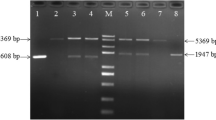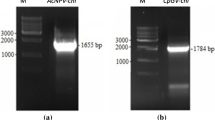Abstract
Two extracellular chitinases were purified from Paecilomyces variotii DG-3, a chitinase producer and a nematode egg-parasitic fungus, to homogeneity by DEAE Sephadex A-50 and Sephadex G-100 chromatography. The purified enzymes were a monomer with an apparent molecular mass of 32 kDa (Chi32) and 46 kDa (Chi46), respectively, and showed chitinase activity bands with 0.01% glycol chitin as a substrate after SDS-PAGE. The first 20 and 15 N-terminal amino acid sequences of Chi32 and Chi46 were determined to be Asp-Pro-Typ-Gln-Thr-Asn-Val-Val-Tyr-Thr-Gly-Gln-Asp-Phe-Val-Ser-Pro-Asp-Leu-Phe and Asp-Ala-X-X-Tyr-Arg-Ser-Val-Ala-Tyr-Phe-Val-Asn-Trp-Ala, respectively. Optimal temperature and pH of the Chi32 and Chi46 were found to be both 60°C, and 2.5 and 3.0, respectively. Chi32 was almost inhibited by metal ions Ag+ and Hg2+ while Chi46 by Hg2+ and Pb2+ at a 10 mM concentration but both enzymes were enhanced by 1 mM concentration of Co2+. On analyzing the hydrolyzates of chitin oligomers [(GlcNAc) n , n = 2–6)], it was considered that Chi32 degraded chitin oligomers as an exo-type chitinase while Chi46 as an endo-type chitinase.






Similar content being viewed by others
References
Agrios GN (2005) Plant pathology. Elsevier Academic Press, New York
Baratto CM, Dutra V, Boldo JT, Leiria LB, Vainstein MH, Schrank A (2006) Isolation, characterization, and transcriptional analysis of the chitinase chi2 gene (DQ011663) from the biocontrol fungus Metarhizium anisopliae var. anisopliae. Curr Microbiol 53:217–221. doi:10.1007/s00284-006-0078-6
Bird AF, McClure MA (1975) The tylenchid (nematode) egg shell: structure, composition and permeability. Parasitology 72:19–28
Bradford MM (1976) A rapid and sensitive method for the quatitation of microgram quantities of protein utilizing the principle of protein-dye. Anal Biochem 72:248–254. doi:10.1016/0003-2697(76)90527-3
Dahiya N, Tewari R, Hoondal GS (2006) Biotechnological aspects of chitinolytic enzymes: a review. Appl Microbiol Biotechnol 71:773–782. doi:10.1007/s00253-005-0183-7
Guthrie JL, Khalif S, Castle AJ (2005) An improved method for detection and quantification of chitinase activities. Can J Microbiol 51:491–495. doi:10.1139/w05-020
Henrissat B (1991) A classification of glycosyl hydrolates based on amino acid sequence similarities. Biochemistry 280:309–316
Hoell IA, Klemsdal SS, Vaaje-Kolstad G, Horn GJ, Eijsink VGH (2005) Overexpression and characterization of a novel chitinase from Trichoderma atroviride strain P1. Biochem Biophysiol ACTA 1748:180–190
Hollis T, Monzingo AF, Bortone K, Ernst S, Cox R, Robertus JD (2000) The X-ray structure of a chitinase from the pathogenic fungus Coccidioides immitis. Protein Sci 9:544–551
Huang XAW, Zhao NH, Zhang KQ (2004) Extracellular enzymes serving as virulence factors in nematophagous fungi involved in infection of the host. Res Microbiol 155:811–816. doi:10.1016/j.resmic.2004.07.003
Imoto T, Yamashita KY (1971) A simple activity measurement of lysozyme. Agric Biol Chem 35:1154–1156
Izume M, Ohtakara A (1987) Preparation of D-glucosamine oligosaccharides by the enzymatic hydrolysis of chitosan. Agric Biol Chem 51:1189–1191
Jung WJ, Kuk JH, Kim KY, Kim TH, Park RD (2005) Purification and characterization of chitinase from Paenibacillus illinoisensis KJA-424. J Microbiol Biotechnol 15:274–280
Kang SC, Park S, Lee DG (1999) Purification and characterization of a novel chitinase from the entomopathogenic fungus, Metarhizium anisopliae. J Invertebr Pathol 73:276–281. doi:10.1006/jipa.1999.4843
Khan A, Williams K, Mark P, Molloy MP, Nevalainen H (2003) Purification and characterization of a serine protease and chitinase from Paecilomyces lilacinus and detection of chitinase activity on 2D gels. Protein Expr Purif 32:210–220. doi:10.1016/j.pep.2003.07.007
Khan A, Williams KL, Nevalainen HKM (2004) Effects of Paecilomyces lilacinus protease and chitinase on the eggshell structures and hatching of Meloidogyne javanica juveniles. Biol Control 31:346–352. doi:10.1016/j.biocontrol.2004.07.011
Kuk JH, Jung WJ, Jo GH, Kim YC, Kim KY, Park RD (2005) Production of N- acetyl-β-D-glucosamine from chitin by Aeromonas sp. GJ-18 crude enzyme. Appl Microbiol Biotechnol 68:384–389. doi:10.1007/s00253-004-1877-y
Laemmli UK (1970) Cleavage of structural proteins during the assembly of the head of bacteriophage T4. Nature 227:680–683. doi:10.1038/227680a0
Leger S, Joshi RJ, Bidochka L, Roberts DW (1996) Characterization and ultrastructural localization of Metarhizium anisopliae, M. flavoviride, and Beauveria bassiana during fungal invasion of host (Manduca sexta) cuticle. Appl Environ Microbiol 62:907–912
Li CD (1998) Review of fungal chitinases. Mycopathology 161:345–360
Luke KA, Higgins CL, Wittung-Stafshede P (2007) Thermodynamic stability and folding of proteins from hyperthermophilic organism. FEBS J 274:4023–4033. doi:10.1111/j.1742-4658.2007.05955.x
Marco JLD, Valadares-Inglis MC (2003) Purification and characterization of an N-acetylglucosaminidase produced by a Trichoderma harzianum strain which controls Crinipellis perniciosa. Appl Microbiol Biotechnol 64:70–75. doi:10.1007/s00253-003-1490-5
Marco JLD, Lima LHC, Sousa MV, Felix CR (2000) A Trichoderma harzianum chitinase destroys the cell wall of the phytopathogen Crinipellis perniciosa, the causal agent of witches’ broom disease of cocoa. J Microbiol Biotechnol 16:383–386
Mavromatis K, Woo MLSL, Bouriotis V (2003) Mode of action and antifungal properties of two cold-adapted chitinases. Extremophiles 7:385–390. doi:10.1007/s00792-003-0338-3
Monreal J, Reese ET (1968) The chitinase of Serratia marcescens. J Microbiol 15:689–696
Morton CO, Hirsch PR, Kerry BR (2004) Infection of plant-parasitic nematodes by nematophagous fungi—a review of the application of molecular biology to understand infection processes and to improve biological control. Nematology 6:161–170. doi:10.1163/1568541041218004
Mukherjee G, Sen SK (2006) Purification, characterization, and antifungal activity of chitinase from Streptomyces venezuelae P10. Curr Microbiol 53:265–269. doi:10.1007/s00284-005-0412-4
Nguyen VN, Jung WJ, Hwangbo H, Kim KY, Nguyen AD, Park RD (2006) Screening of chitinolytic and chitosanolytic fungi and the application for controlling plant-parasitic nematode Meloidogyne sp. In: Kim SK, No HK, Park RD (eds) Advances in Chitin Science and Technology. Hanrimwon Printing, Seoul, pp 254–256
Nguyen VN, Kim YJ, Oh KT, Jung WJ, Park RD (2007) The role of chitinase from Lecanicillium antillanum B-3 in parasitism to root-knot nematode Meloidogyne incognita eggs. Biocontrol Sci Technol 17:1047–1058. doi:10.1080/09583150701668658
Nguyen VN, Kim YJ, Oh KT, Jung WJ, Park RD (2008) The antifungal activity of chitinases from Trichoderma aureoviride DY-59 and Rhizopus microsporus VS-9. Curr Microbiol 56:28–32. doi:10.1007/s00284-007-9033-4
Patil RS, Ghormade V, Deshpande MV (2000) Chitinolytic enzymes: an exploration. Enzyme Microb Technol 26:473–483. doi:10.1016/S0141-0229(00)00134-4
Pohl T (1990) Concentration of protein and removal of solutes. In: Deutscher WP (ed) Guide to protein purification. Metho enzymol 182. Academic Press, London, pp 68–83
Sahai AS, Manocha MS (1993) Chitinases of fungi and plants: their involvement in morphogenesis and host-parasite interaction. FEMS Microbiol Rev 11:317–338. doi:10.1111/j.1574-6976.1993.tb00004.x
Seidl V, Huemer B, Seiboth B, Kubicek CP (2005) A complete survey of Trichoderma chitinases reveals three distinct subgroups of family 18 chitinases. FEBS J 272:5923–5939. doi:10.1111/j.1742-4658.2005.04994.x
Tikhonov VE, Lopez-Llorca LV, Salinas J, Jansson HB (2002) Purification and characterization of chitinases from the nematophagous fungi Verticillium chlamydosporium and V. suchlasporium. Fungal Genet Biol 35:67–78. doi:10.1006/fgbi.2001.1312
Toharisman A, Suhartono T, Barth MS, Hwang JK, Pyun YR (2005) Purification and characterization of a thermostable chitinase from Bacillus licheniformis Mb-2. J Microbiol Biotechnol 21:733–738
Tronsmo A, Harman GE (1993) Detection and quatification of N-acetyl-β-D-glucosaminidase, chitobiosidase, and endochitinase in solutions and on gels. Anal Biochem 208:74–79. doi:10.1006/abio.1993.1010
Trudel J, Asselin A (1989) Detection of chitinase activity after polyacrylamide gel electrophoresis. Anal Biochem 178:362–366. doi:10.1016/0003-2697(89)90653-2
Wang SY, Moyne AL, Thottappilly G, Wu SJ, Locy RD, Singh NK (2001) Purification and characterization of a Bacillus cereus exochitinase. Enzyme Microb Technol 28:492–498. doi:10.1016/S0141-0229(00)00362-8
Watanabe T (2002) Pictorial atlas of soil and seed fungi morphologies of cultured fungi and key to species, 2nd edn. CRC Press, New York
White TG, Brunst T, Lee S, Taylor J (1990) Amplification and direct sequencing of fungal ribosomal RNA genes for phylogenetics. Guide to Methods and Applications. Academic press, London, pp 315–322
Zaldivar M, Velasquez JC, Contreras I, Perez LM (2001) Trichoderma aureoviride 7–121, a mutant with enhanced production of lytic enzymes: its potential use in waste cellulose degradation and/or biocontrol. Electron J Biotechnol 4:1–9
Zeilinger S, Galhaup C, Payer K, Woo SL, Mach RL, Fekete C, Lorito M, Kubicek CP (1999) Chitinase gene expression during mycoparasitic interaction of Trichoderma harzianum with its host. Fungal Genet Biol 26:131–140. doi:10.1006/fgbi.1998.1111
Acknowledgments
This work was supported by the Korea Science and Engineering Foundation (KOSEF) through the National Research Lab. Program funded by the Ministry of Science and Technology (No. 10300000322-06J0000-32210).
Author information
Authors and Affiliations
Corresponding author
Rights and permissions
About this article
Cite this article
Nguyen, VN., Oh, IJ., Kim, YJ. et al. Purification and characterization of chitinases from Paecilomyces variotii DG-3 parasitizing on Meloidogyne incognita eggs. J Ind Microbiol Biotechnol 36, 195–203 (2009). https://doi.org/10.1007/s10295-008-0485-8
Received:
Accepted:
Published:
Issue Date:
DOI: https://doi.org/10.1007/s10295-008-0485-8




